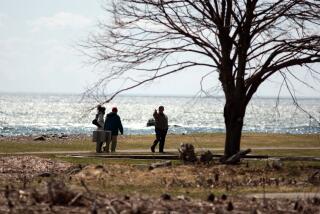Once-wayward humpbacks appear to be home free
SACRAMENTO — They came, they wandered, they went.
After a 17-day sojourn in Northern California’s inland waterways, two wayward humpback whales that caught the attention of the nation appear to have quietly slipped back into the Pacific Ocean.
By late Wednesday, nearly 24 hours after they were last sighted off the Marin County town of Tiburon, the mother and her calf were nowhere to be seen. Most of the experts mounting a rescue operation concluded that the pair had found their way back to their ocean home.
A pair of patrol boats from the U.S. Coast Guard and California Department of Fish and Game hunted the waters off the coast for any sign of the pair, while vessels crisscrossing San Francisco Bay were asked to notify authorities of any sighting.
Not a tail slap, spout or sky-scratching breach was seen.
“They arrived here quietly, and if they’ve made their way outside the Golden Gate, they’ve gone out quietly,” said Bernadette Fees, a state Fish and Game spokeswoman.
First spotted swimming languidly May 13, the pair arrived in the Sacramento River sporting deep gashes likely inflicted by a run-in with a ship. They wandered into a deep-water shipping channel and into the Port of Sacramento, meandering 70 miles from the sea.
In the days that followed, whale experts from around the nation descended on the area to lend a hand.
The rescue team received thousands of e-mails and calls from the public, expressing concern and offering suggestions. Northern Californians took off workdays to perch on riverbank levees to get a glimpse.
Experts faced a tough balance between giving the whales room to relax and heal and trying to persuade them to head back to their natural saline environment, where their wounds would better heal.
The rescue team used clanking pipes, recordings of killer whales and even the geyser spray of a fireboat in an unsuccessful bid to prod the whales past what became their biggest obstacle -- a bustling bridge at Rio Vista.
Scientists grew worried late last week as the pair’s health continued to deteriorate. By the weekend, the team resorted to administering a dose of antibiotics -- a first for whales in the wild -- delivered with foot-long syringes shot from a .22-caliber rifle. They prepared to launch a massive post-Memorial Day push to move the whales.
The whales beat them to the punch.
On Sunday, they made their break amid the buzz of holiday jet skiers and boaters on the river. Over three days, they moved purposefully down the river, through the narrow Carquinez Strait and into San Francisco Bay. Seeming to gain vigor, the 20-foot-long juvenile put on a display of leaps and tail slaps as if at play.
Tara Cahn, a Sausalito architect, jumped in her car upon learning that the whales were swimming along the Marin County coast. After a few wrong turns, she finally tracked them down Tuesday evening about a quarter-mile offshore of Tiburon.
“They were bouncing around, they were playing, they were spouting,” said Cahn, who on Wednesday was out looking for them again. “I’ve been whale watching on Monterey Bay, and this was far more exciting.”
Scientists say the pair’s health rebounded after they returned to the bay’s soothing saltwater. Their skin, which grew pitted during their trip up the Sacramento River, was looking slick and slippery by Tuesday evening.
“We’re still holding our breath a little bit, but we’re just so pleased,” said Trevor Spradlin, a marine mammal biologist with the National Oceanic and Atmospheric Administration Fisheries, the federal agency that helped lead the rescue effort.
Spradlin said scientists are coming away with a treasure trove of insights and observations that will fuel months of research.
“We will rigorously and systematically document this case. Really, the only other reference point was Humphrey, and that was a long time ago,” he said, referring to the wayward humpback that spent nearly a month in the delta in 1985.
Scientists were delighted that they pulled off the antibiotic shots, but disappointed that they never got to put a satellite tracking tag on the mother.
Tests should soon tell them whether the whales are part of the group that migrates between Mexico and British Columbia or the clan that winters in the Hawaiian Islands. They also hope to learn the gender of the calf, which, at about half the length of its 45-foot-long mother, might have been a yearling that was still nursing.
Questions arose early about the cost of the rescue effort. Officials say they haven’t calculated the price tag. But they say it was well worth it to save a breeding mother and her calf, representatives of a species that has been on the federal endangered list since 1970.
Armed with photos of the pair’s distinctive tails, experts should be able to pick out the wayward duo as they migrate up the coast.
In the meantime, “these whales have been fantastic ambassadors for the ocean,” Spradlin said.
Officials said the public almost universally responded with empathy for the whales. Perhaps it was that they were a mother and child, or the vulnerability caused by their wounds. Or perhaps it was because they were strangers cast adrift in a strange realm.
“It really showed the love people have for whales,” said John Calambokidis of the Cascadia Research Collective, who said he hoped it would “translate into protection of whale populations, and that means protection of the marine environment” as a whole.
On the Marin County shoreline near the Golden Gate Bridge, Tara Cahn rooted the whales on. She said she was happy to see them up close, but was even more delighted to have them headed back where they belong.
“I hope,” she said, “they’ve made it home.”
*
More to Read
Sign up for Essential California
The most important California stories and recommendations in your inbox every morning.
You may occasionally receive promotional content from the Los Angeles Times.










